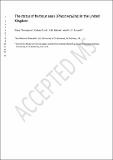The status of harbour seals (Phoca vitulina) in the UK
Abstract
1. Estimates of population size and trends are essential for effective conservation and management of wildlife populations. For harbour seals (Phoca vitulina), these data are required to fulfil statutory reporting obligations under national and international regulations. 2. Aerial survey counts of harbour seals hauled out during their annual moult were used to estimate population sizes and trends at UK, regional (seal management unit, SMU) and local (Special Area of Conservation, SAC) scales. 3. Results indicate that the current UK harbour seal population is similar to estimates from the late 1990s, but there were significant declines in some subpopulations and increases in others. 4. Fitted trends suggest that the UK harbour seal population can be divided into three geographically coherent groups: South‐east populations (South‐East and North‐East England SMUs) have shown continuous increases punctuated by phocine distemper virus epidemics in 1988 and 2002; north‐east populations (East Scotland, Moray Firth, North Coast and Orkney, and Shetland SMUs) have declined since the late 1990s; north‐west populations (West Scotland, Western Isles, and South‐West Scotland SMUs) have remained stable or increased. Similar geographical population substructure is evident in recent population genetics results. 5. Trends within SACs generally match SMU trends since 2002. Of the nine SACs designated for harbour seals, four declined (in East Scotland, Moray Firth, and North Coast and Orkney SMUs), four remained stable (in Shetland and West Scotland SMUs), and one increased (in South‐East England SMU). 6. Large changes in relative abundance have resulted from differences in regional trends. For example, in 1996–1997 the West Scotland and North Coast and Orkney SMUs each held ~27% of the Great Britain population but now hold ~50% and ~4% respectively; in 1980, the South‐East England SMU population was ~50% that of the Wadden Sea population, but by 2016 it was equivalent to <20% of the Wadden Sea count.
Citation
Thompson , D , Duck , C D , Morris , C D & Russell , D J F 2019 , ' The status of harbour seals ( Phoca vitulina ) in the UK ' , Aquatic Conservation: Marine and Freshwater Ecosystems , vol. 29 , no. S1 , pp. 40-60 . https://doi.org/10.1002/aqc.3110
Publication
Aquatic Conservation: Marine and Freshwater Ecosystems
Status
Peer reviewed
ISSN
1052-7613Type
Journal article
Description
Surveys in England and the Moray Firth were funded by the UK Natural Environment Research Council (National Capability Grant no. SMRU1001). Surveys in the rest of Scotland were funded by Scottish Natural Heritage and surveys in Northern Ireland were funded by The Department of Trade and Industry, Marine Current Turbines, and the Northern Ireland Department of Agriculture, Environment and Rural Affairs.Collections
Items in the St Andrews Research Repository are protected by copyright, with all rights reserved, unless otherwise indicated.

